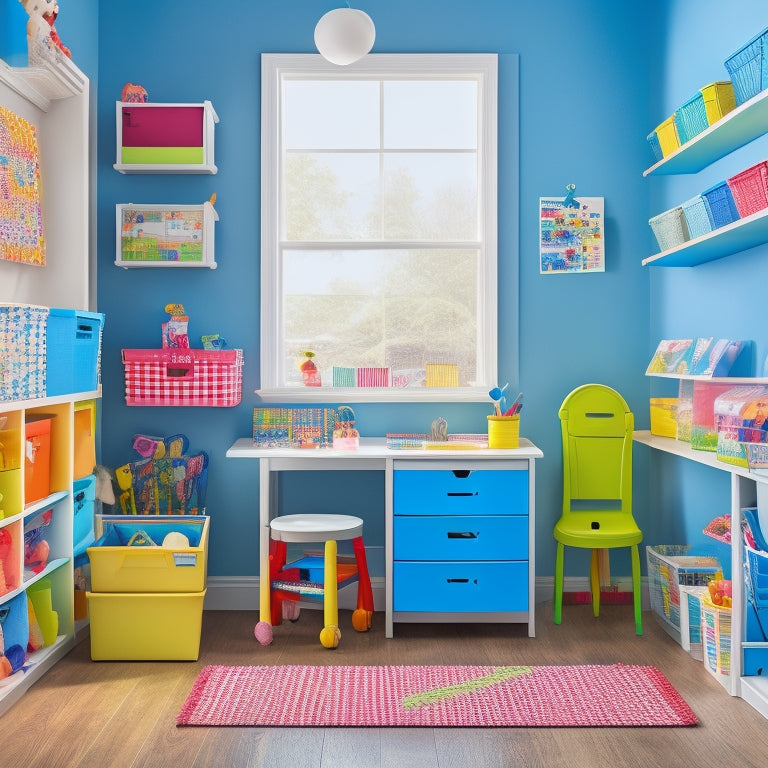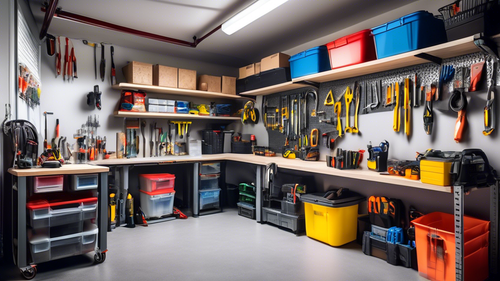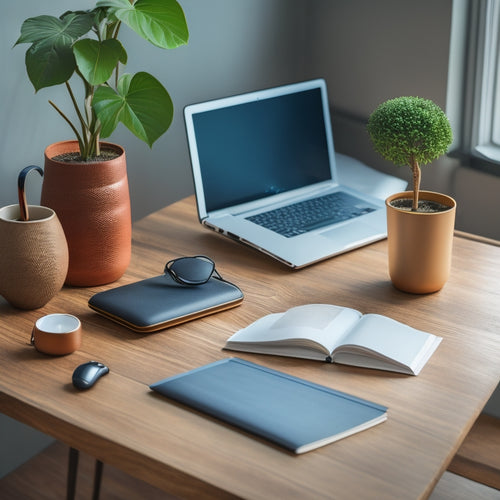
10 Essential Home Organization Hacks for Kids
Share
You're about to change your kids' spaces into organized havens that encourage independence, responsibility, and a lifelong love for cleanliness. Start by categorizing toys, labeling storage bins, and designating a specific spot for every item. Employ vertical shelf space and maximize storage under beds. Create a homework station and establish daily routines and weekly clean-ups to maintain tidiness. Teach your kids to put away their belongings and schedule tasks to promote a sense of ownership. By implementing these essential hacks, you'll set your kids up for success - and uncover even more ways to create a clutter-free, stress-free home as you go.
Key Takeaways
- Categorize toys into groups and implement a toy rotation system to reduce overwhelm and encourage organization.
- Use labeled storage bins with color coding to maintain a clutter-free playroom and teach responsibility.
- Assign a specific spot for every toy, book, and game to create designated zones and encourage the habit of returning items.
- Maximize storage capacity by utilizing vertical shelf space, multi-purpose furniture, and under-bed storage solutions.
- Establish a daily routine that includes cleaning and maintaining spaces to promote habits that foster cleanliness and organization.
Sorting Toys by Category
You're probably no stranger to the chaos that can ensue when toys and games are scattered all over the room. To regain control, sort toys by category, and consider implementing a toy rotation system. This will help reduce overwhelm and keep your child engaged.
Start by categorizing toys into groups like building, art, and imagination. Assigning specific homes for items, as suggested in Revamp Your Space, can also enhance retrieval and organization.
Then, assign a specific color to each category, making it easy for your child to identify where each toy belongs. Use category colors to label storage bins and shelves, keeping everything organized and accessible.
Creating a Homework Station
Now that toys are sorted and categorized, it's time to focus on creating a dedicated space for homework. You'll want to set up a distraction-free zone that promotes focus and productivity.
Start by designating a quiet space with comfortable seating and gather all necessary homework supplies within easy reach.
Implement creative organization strategies, such as using visual cues, to help your child prioritize tasks and manage their time effectively. Consider setting a timer for study breaks to maintain a healthy balance.
This space will also be perfect for collaborative projects, allowing your child to work with others without distractions.
Labeling Storage Bins Clearly
Several labeled storage bins can make a significant difference in maintaining a clutter-free playroom. By labeling each bin clearly, you're teaching your kids to put away toys and materials after use, promoting a sense of responsibility and organization.
Invest in a label maker to create crisp, easy-to-read labels. Consider bin color coding to categorize similar items, such as art supplies or building blocks. This visual system helps kids quickly identify where items belong, making cleanup a breeze.
Be specific with your labels, using words like "Crayons" or "Dinosaurs" instead of vague terms like "Toys." This way, you're creating a system that's easy for kids to follow, and they'll be more likely to stick to it.
Using Over-the-Door Storage
Beyond the benefits of labeled storage bins, consider maximizing your playroom's vertical space with over-the-door storage solutions.
You can install over-the-door organizers on the back of a door or on a wall to create additional storage for your kids' toys, books, and accessories. These creative storage solutions are perfect for small items like puzzles, games, or art supplies.
Look for over-the-door organizers with pockets, hooks, or baskets to keep items organized and within reach. By using over-the-door storage, you'll free up floor space, reduce clutter, and keep your playroom tidy.
Plus, it's an easy way to teach your kids to put things back in their place, promoting good habits and responsibility.
Designating a Place for Everything
Every toy, book, and game in your kid's playroom needs a designated spot, making it easier for them to find what they need and put things back where they belong.
By creating designated zones for different types of toys and activities, you'll encourage your kids to maintain clutter-free spaces. Label each zone so your kids know exactly where to find what they're looking for.
For example, you can have a "building zone" for blocks and Legos, a "reading nook" for books, and a "dress-up corner" for costumes.
This system helps your kids develop the habit of putting things back in their assigned spot, teaching them responsibility and keeping their playroom organized.
Implementing a Daily Routine
Your kid's daily routine should include specific times for cleaning up and maintaining their designated spaces, making it a habit that becomes second nature.
Create a morning checklist to guarantee they start the day on track. This can include tasks like making their bed, putting away toys, and packing their backpack.
In the evening, establish a wind-down routine to help them unwind and prepare for the next day. This might include tidying up their room, laying out clothes for the next day, and packing any necessary items.
Maximizing Space Under Bed
You can create extra storage in your bedroom by utilizing the often-wasted space under your bed.
By incorporating bed risers, under-bed containers, or sliding drawer systems, you'll be able to stash items like out-of-season clothes, linens, or even toys and games.
This will help keep your floor clear and make your room feel more organized and peaceful.
Bed Risers for Storage
Bed risers can be a revolutionary solution for kids' bedrooms, offering a wealth of hidden storage space that's just waiting to be tapped.
By elevating your child's bed, you're creating a whole new area for creative storage. Look for bed risers with adjustable heights to customize the space to your needs. This will give you the flexibility to store items of varying sizes, from out-of-season clothing to bulky toys.
With bed risers, you can finally clear the clutter from the floor and keep your child's bedroom tidy. Plus, the extra space will encourage your kid to keep their belongings organized, teaching them essential habits for life.
Under Bed Containers
By utilizing the newly created space under the bed, you can optimize storage capacity with under-bed containers. This under bed organization hack is a creative storage solution that keeps clutter at bay.
You can store items like:
- Out-of-season clothing or blankets
- Bedding and linens
- Books, toys, or board games
- Art supplies or craft materials
Under-bed containers come in various sizes and styles, making them versatile and easy to use.
They're perfect for kids' bedrooms, where space is often limited. By using under-bed containers, you can keep the floor clear, making it easier to clean and maintain a sense of control over the room's organization.
Sliding Drawer Systems
Taking storage to the next level, sliding drawer systems maximize space under the bed, providing a convenient and accessible way to stash belongings.
You can install these systems under your kid's bed, allowing them to store out-of-season clothes, toys, or linens. The sliding mechanisms make it easy for your child to access their belongings without having to dig through cluttered containers.
This drawer organization system keeps items organized, making it simpler for your kid to find what they need. By utilizing the often-wasted space under the bed, you're teaching your child the importance of maximizing storage and maintaining a clutter-free environment.
Utilizing Vertical Shelf Space
You can make the most of your kid's room by using vertical shelf space to maximize storage capacity.
By stacking shelves, you can fit more items in a smaller footprint, keeping the floor clear and making the room feel more spacious.
Label each shelf so your kid can easily find what they need, and teach them to put things back in their designated spot.
Maximize Storage Capacity
About three-quarters of the storage capacity in a typical kid's room remains unused - and that's a lot of wasted space!
You can maximize storage capacity by making the most of your child's room's vertical space.
-
Invest in multi-purpose furniture like storage beds or desks with built-in shelves to keep clutter at bay.
-
Employ stackable containers or bins to store items like toys, books, or clothes.
-
Install floor-to-ceiling shelves or bookcases to store items that are less frequently used.
- Hang organizers or hooks on the back of doors to store items like jackets, bags, or accessories.
Label Each Shelf
Five levels of vertical shelf space await optimization in your kid's room. By labeling each shelf, you create a clear and organized system that encourages your child to maintain their belongings. This is especially effective when combined with color coding, where similar items are grouped together and assigned a specific color.
| Shelf Level | Category | Label |
|---|---|---|
| Top | Books | Reading Nook |
| Middle | Toys | Playtime Favorites |
| Bottom | Art Supplies | Creative Corner |
Assign a specific category to each shelf, and use a label maker to create clear and concise labels. This visual system helps your kid quickly identify where items belong, promoting shelf organization and reducing clutter.
Teaching Kids to Put Away
In the midst of chaotic mornings and hectic afternoons, one essential habit can make all the difference: teaching kids to put away their belongings. This habit not only helps maintain a tidy space but also instills responsibility and independence in your kids.
To make it stick, try these strategies:
- Create a reward system: Offer stickers or small treats for each item put away correctly.
- Make it a fun challenge: Set a timer and see who can put away their toys the fastest.
- Assign specific tasks: Designate a specific area or toy for each child to put away.
- Lead by example: Show your kids that putting away belongings is a habit for everyone, not just them.
Scheduling Weekly Clean-Ups
You'll want to schedule weekly clean-ups to maintain your kid's newly organized space.
Assign daily tasks to your kids to keep their area tidy, and set aside one day a week to clean up together as a team.
This consistent routine will help them develop good habits and a sense of responsibility.
Daily Tasks Assigned
Throughout their daily routines, kids can develop a sense of responsibility and ownership by being assigned specific tasks that contribute to maintaining a tidy living space. By assigning daily tasks, you'll help your kids establish habits that'll benefit them throughout their lives.
To implement daily tasks effectively, consider the following:
-
Create a chore chart that outlines each child's responsibilities and the frequency of tasks.
-
Establish a reward system that motivates kids to complete their tasks on time.
-
Assign age-appropriate tasks that are achievable and manageable for each child.
- Rotate tasks periodically to guarantee kids learn new skills and don't get bored with repetitive tasks.
Clean Up Together
By working together on daily tasks, you've laid the groundwork for a sense of responsibility and teamwork in your kids.
Now it's time to take it to the next level by scheduling weekly clean-ups. Set a specific day and time each week for a family clean-up session.
Make it fun by turning cleaning into games, such as a timed challenge or a scavenger hunt for toys and clutter. Offer teamwork rewards for a job well done, like a special outing or dessert.
This won't only keep your home tidy but also encourage a sense of accomplishment and cooperation in your kids.
Remember to rotate tasks and responsibilities to keep things interesting and prevent boredom.
With consistent effort, you'll be raising kids who understand the value of teamwork and cleanliness.
Frequently Asked Questions
How Do I Motivate My Kids to Maintain Their Organized Space?
You'll motivate your kids to maintain their organized space by implementing reward systems and encouraging family involvement, making it a fun, collaborative process where everyone benefits, and they'll be more likely to stick to it.
Can I Use These Hacks for Children With Special Needs?
You can adapt these hacks for kids with special needs by using visual aids and sensory bins to help them understand and engage with the organization process, making it more accessible and enjoyable for them.
Are These Hacks Suitable for Small or Shared Bedrooms?
When in doubt, scale it out! You'll find that space optimization is key in small or shared bedrooms. By assigning shared responsibilities, you'll create a clutter-free zone that's functional and peaceful, perfect for kids to thrive in.
How Often Should I Rotate Toys to Keep Things Interesting?
You'll want to rotate toys every 2-3 months to maintain engagement; try categorizing toys by type, then swap out 25-50% of them to keep things fresh and exciting, ensuring your little ones stay curious and interested.
Can I Adapt These Hacks for Children of Different Ages?
You think one-size-fits-all organization hacks will magically work for kids of different ages? Think again! You'll need age-specific adaptations that consider developmental stages, so tailor your approach to their unique needs, and watch their independence and responsibility bloom.
Related Posts
-

Garage Organization Tips for Overcrowded Spaces
Decluttering and Maximizing Space If your garage has become an unmanageable clutter zone, it's time to reclaim you...
-

Mastering Digital Decluttering With 5 Essential Tools
You're tired of feeling overwhelmed by your digital clutter, and it's time to take control. To master digital declutt...

